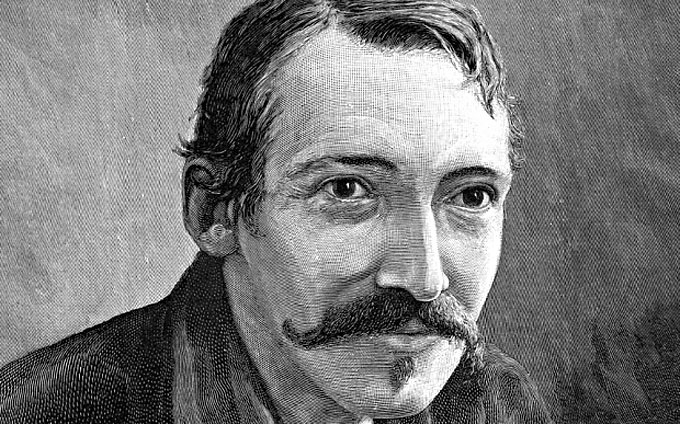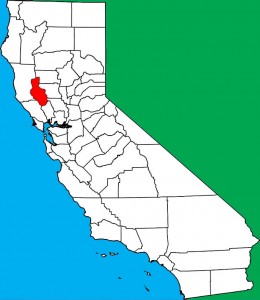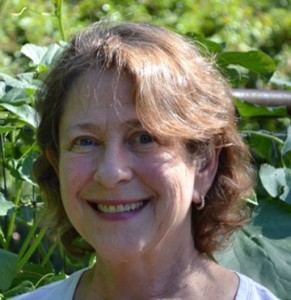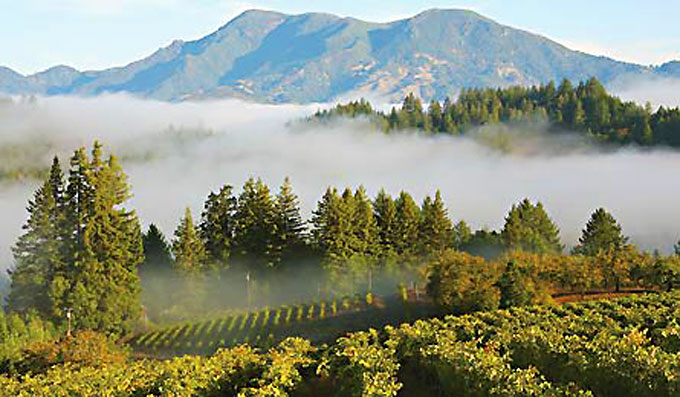
John Steinbeck, a fan since childhood of Robert Louis Stevenson, wrote a short story featuring the Treasure Island author 75 years ago. Stevenson, a frail but fearless Scotsman, pursued the woman he loved—a married American mother he met in London—all the way to the Monterey Peninsula in the late 1870s, the background for Steinbeck’s 1941 magazine story, “How Edith McGillicudy Met Robert Louis Stevenson.” A month after her divorce in 1880, Fanny Osbourne married Robert Louis Stevenson, spending a two-month honeymoon with her young husband camped out on Mt. St. Helena in northern Napa County, where he wrote a book about their adventure called The Silverado Squatters. The couple later settled in the South Seas with Stevenson’s adopted family; fame, fortune, and the author’s early death soon followed. A museum in the Napa town of St. Helena, California, is dedicated to Stevenson and the book. The Mt. St. Helena peak where it all happened was named Robert Louis Stevenson State Park.
What does this history have to do with John Steinbeck? A recent Fourth of July vacation spent at an isolated Lake County bed and breakfast inspired by images of Eden proved: quite a lot.
 Unlike Napa to the south and Sonoma and Mendocino counties to the west, Lake County, California, isn’t much of a tourist destination. Like Stevenson’s honeymoon, our bed-and-breakfast getaway was intended to, well, get away from it all. Mendocino was the original setting of John Steinbeck’s second novel, To a God Unknown, but the hot, dry valley at the heart of Lake County feels much more like the novel than its neighboring county. It’s a placid place, dominated by a large lazy lake, horse farms, and vineyards scattered among rolling hills not unlike those of the Salinas Valley. The roads from Sonoma, Mendocino, and Napa wine country to Lake County are sharp and steep, and Clear Lake is lower than usual due to California’s prolonged drought. Visitors to Lake County really want to be there. They always did. The legendary British beauty Lily Langtree, mistress of King Edward VII at the time Robert Louis Stevenson was pursuing Fannie Osbourne, came to Lake County in 1897 to divorce her husband-of-the-moment, a rich American who promptly died. Before she left she bought a winery that still bears her name, not far from Middletown (pop. 1,500), the closest community to the idyllic bed and breakfast where our John Steinbeck story began two weeks ago.
Unlike Napa to the south and Sonoma and Mendocino counties to the west, Lake County, California, isn’t much of a tourist destination. Like Stevenson’s honeymoon, our bed-and-breakfast getaway was intended to, well, get away from it all. Mendocino was the original setting of John Steinbeck’s second novel, To a God Unknown, but the hot, dry valley at the heart of Lake County feels much more like the novel than its neighboring county. It’s a placid place, dominated by a large lazy lake, horse farms, and vineyards scattered among rolling hills not unlike those of the Salinas Valley. The roads from Sonoma, Mendocino, and Napa wine country to Lake County are sharp and steep, and Clear Lake is lower than usual due to California’s prolonged drought. Visitors to Lake County really want to be there. They always did. The legendary British beauty Lily Langtree, mistress of King Edward VII at the time Robert Louis Stevenson was pursuing Fannie Osbourne, came to Lake County in 1897 to divorce her husband-of-the-moment, a rich American who promptly died. Before she left she bought a winery that still bears her name, not far from Middletown (pop. 1,500), the closest community to the idyllic bed and breakfast where our John Steinbeck story began two weeks ago.
 The Backyard Garden Oasis Bed and Breakfast consists of three cottages on Mt. St. Helena farmland populated by grazing horses and the occasional coyote. Greta Zeit, a native of New York, bought the farm in 1995, built the comfortable cottages, and created an organic food lover’s dream in the garden for which her bed and breakfast is aptly named. Country quiet with the family dogs—not John Steinbeck—was the purpose of our getaway to Greta’s bed and breakfast. But surprise: John Steinbeck became the topic of conversation at breakfast each morning of our stay. Ed, a young green-energy consultant from San Francisco, exclaimed “I love John Steinbeck!” when first introduced. Another guest, a special education teacher visiting with her husband from Oklahoma, confirmed that Steinbeck has been forgiven and The Grapes of Wrath is now encouraged reading in the state’s schools. A third guest, from Berkeley, works as a sales rep for Penguin, the publisher of John Steinbeck’s books. She said business is very, very good. Greta, our warmhearted host, was reading East of Eden. She wondered if the Trasks were a real family, like the Hamiltons.
The Backyard Garden Oasis Bed and Breakfast consists of three cottages on Mt. St. Helena farmland populated by grazing horses and the occasional coyote. Greta Zeit, a native of New York, bought the farm in 1995, built the comfortable cottages, and created an organic food lover’s dream in the garden for which her bed and breakfast is aptly named. Country quiet with the family dogs—not John Steinbeck—was the purpose of our getaway to Greta’s bed and breakfast. But surprise: John Steinbeck became the topic of conversation at breakfast each morning of our stay. Ed, a young green-energy consultant from San Francisco, exclaimed “I love John Steinbeck!” when first introduced. Another guest, a special education teacher visiting with her husband from Oklahoma, confirmed that Steinbeck has been forgiven and The Grapes of Wrath is now encouraged reading in the state’s schools. A third guest, from Berkeley, works as a sales rep for Penguin, the publisher of John Steinbeck’s books. She said business is very, very good. Greta, our warmhearted host, was reading East of Eden. She wondered if the Trasks were a real family, like the Hamiltons.
 So much coincidence in such a short space. I was curious. Could I find other John Steinbeck books in Lake County if I looked far enough? The answer was no, but the news was encouraging. The friendly folks at the dozen-plus thrift and vintage stores that dot Clear Lake all said the same thing: when we get a book by Steinbeck, it’s picked up faster than a lampshade by Tiffany. The nearest trade bookstore, across the Lake County line in Ukiah, featured a fat shelf of John Steinbeck Penguins—Of Mice and Men, The Grapes of Wrath, East of Eden—kept in stock to meet the required reading demands of Mendocino County’s schools. The helpful owner of Ukiah’s used bookshop admitted he couldn’t keep Steinbeck’s books in his store. The reason, he explained, was simple: John Steinbeck still sells, even in Robert Louis Stevenson country. That discovery gratified this Lake County traveler, and Charley would be pleased with accommodations. We’ll be back!
So much coincidence in such a short space. I was curious. Could I find other John Steinbeck books in Lake County if I looked far enough? The answer was no, but the news was encouraging. The friendly folks at the dozen-plus thrift and vintage stores that dot Clear Lake all said the same thing: when we get a book by Steinbeck, it’s picked up faster than a lampshade by Tiffany. The nearest trade bookstore, across the Lake County line in Ukiah, featured a fat shelf of John Steinbeck Penguins—Of Mice and Men, The Grapes of Wrath, East of Eden—kept in stock to meet the required reading demands of Mendocino County’s schools. The helpful owner of Ukiah’s used bookshop admitted he couldn’t keep Steinbeck’s books in his store. The reason, he explained, was simple: John Steinbeck still sells, even in Robert Louis Stevenson country. That discovery gratified this Lake County traveler, and Charley would be pleased with accommodations. We’ll be back!



In “Across the Plains,” Stevenson highlighted how Dennis Kearney, the communist rabble-rouser, urged the citizens of Monterey to “hang David Jack.” Years later during an oral history project Jack’s daughter Margaret maintained that Stevenson was ill-disposed towards Jack because Jack had declined him a loan of money. Stevenson was down at heel at the time, and his literary fame was ahead of him. Interestingly, Jack’s family appears in some of Steinbeck’s works, i.e. Margaret & Romie.
Thank you for this interesting insight from the inside. As you imply, Stevenson’s career path was similar to Steinbeck’s: steep and hard before success and fame. Did celebrity spoil either author?
Will,
sounds like a great getaway. A question, though. I always thought To a God Unkown had been set in South Monterey County, around Jolon. Always made sense to me, since that country is still wild and remote.
Stevenson, by the way, caused havoc on the Monterey Peninsula.
He nearly burned down Pacific Grove – he wrote he was curious if the moss hanging from the pines and cypresses burned (Mark Twain did a similar thing at Lake Tahoe – it’s something about brilliant writers).
And then of course Stevenson was thrown from a buggy when his horse was startled by a rattlesnake at the entrance to Carmel Valley, which today is a driving, not snake, hazard. Stevenson hit his head and a bear hunter took him to his cabin and nursed him back to health. So we owe “Kidnapped,” “Treasure Island,” etc. to a Carmel Valley bear hunter.
The horse trotted back to Monterey and for days Fanny and others worried about Stevenson till he showed up with a bandage wrapped about his head.
And then there was the time . . .
If these stories are not true I don’t want to know about it – I like them.
Good memory! You’re right about Jolon Valley, in southern Monterey County, being the setting of John Steinbeck’s novel “In Dubious Battle.” As the great Steinbeck scholar Robert DeMott notes in his introduction to the Penguin edition of the book, however, the story line evolved from an uncompleted stage play called “The Green Lady” written by Steinbeck’s Stanford classmate and Monterey lawyer Webster Street, who set the play in Mendocino, not Monterey County. In fact, DeMott adds, Steinbeck and Street drove to Laytonville, a Mendocino County town, in February 1929 to check out the scene, which Steinbeck rejected in adapting (with permission) his friend’s unfinished script. DeMott explains that this “key decision” was made because Steinbeck “felt no emotional attachment” to the Mendocino landscape, but “had spent summers on his uncle Tom Hamilton’s ranch in King City, not far from Jolon.” Coincidentally, DeMott’s fact-filled introduction opens with a reference to Stevenson: “In the margin of an older sister’s copy of Robert Louis Stevenson’s ‘Prince Otto,’ a very young John Steinbeck marked in pencil his intention to be a writer.” (“To a God Unknown,” with an introduction and notes by Robert DeMott, was published by Penguin Books in 1995 and is the standard reading and teaching edition of the novel.)
Will,
I think I told you years ago someone anonymously dropped off an unpublished letter (to my knowledge) with me from Steinbeck to Toby Street that is the darkest letter by Steinbeck I have ever read. I have based some stories on it. At one point Steinbeck wrtes to Toby: “You are one of the very few people left who do not quote me. That is why I am writing all this.” Unfortunately, the letter is not dated.
Meanwhile, speaking of Jolon, a Bay Area couple into the gallery today who were just down there, visiting Mission San Antonio. They love Monterey’s South County. It’s a mysterious land, perfect setting for a story like “To a God Unkown.”
I was in a bookshop in Inverness, Scotland, just the other day, and picked up a book containing many of RLS’s letters home from America. One of the letters I read happened to be the one in which he mentions setting fire to the forest. Regards the question of whether fame spoiled both writers; I suspect that fame rather spoiled it for them to a large extent.
Thank you for sharing this fascinating discovery about Stevenson’s formerly rumored, now confirmed sideline as an arsonist during his brief stay on the Monterey Peninsula. Perhaps married life and commercial success improved his behavior, at least on the fire-front, after he left!
Just found the below on the RLS website. Always told it was Pacific Grove, and the reference to Monterey might be the general region, and it happened in Pacific Grove.
While in Monterey, RLS also started a forest fire. He was fascinated by the many fires that spring up in the Californian forests and wondered whether it was the moss growing on the trees that first caught fire. The moss did catch fire – and quickly spread. RLS later described the incident in “The Old Pacific Capital” (1880).
In early November he also wrote about the fire to W.E. Henley: “Yesterday I set fire to the forest, for which, had I been caught, I should have been hung out of hand to the nearest tree; Judge Lynch being an active person hereaway. You should have seen my retreat (which was entirely for strategical purposes). I ran like hell. It was a fine sight. At night I went out again to see it; it was a good fire, though I say it that should not”
Presumably the incident was not the inspiration for Henley’s poem ‘Invictus,’ though I’ve always taken pleasure in the fact that William Ernest was his name as well as mine. End of similarity.